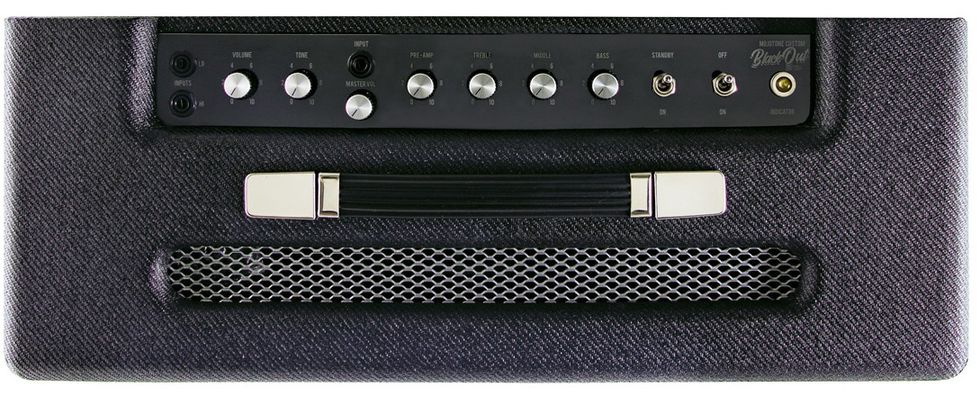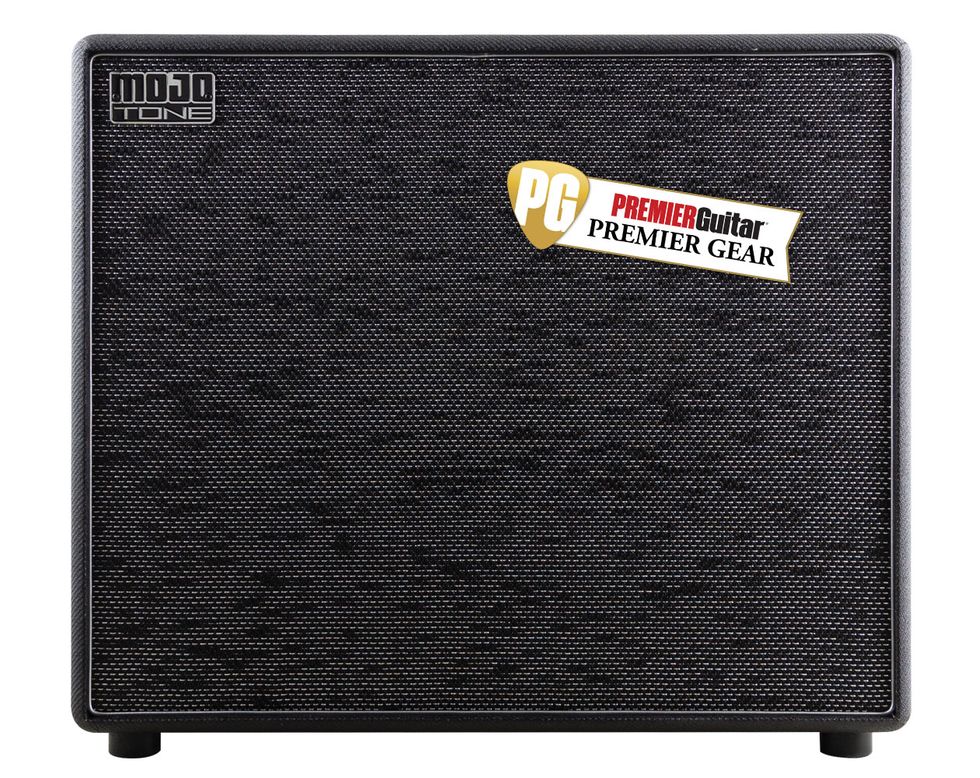Recorded using a Royer R-121 feeding an Audient iD44 going into GarageBand with no EQ-ing, compression, or effects.
Clip 1: Squier Classic Vibe '60s Strat into Anasounds Element reverb, then into Mojotone gain channel with master volume at max, preamp at 8 o'clock, treble and bass at max, and middle at noon. All pickup positions, beginning with neck pickup.
Clip 2: Gibson Les Paul Traditional with 57 Classic bridge pickup into Mojotone gain channel with master volume at max, preamp at 8 o'clock, treble and bass at max, and middle at noon.
RatingsPros:Lovely semi-clean to moderately saturated tones. Impressive build. Fantastic bang for buck. Cons: Not a ton of clean headroom. Street: $1,199 Mojotone BlackOut British mojotone.com | Tones: Ease of Use: Build/Design: Value: |
Marshall's original 18-watt combos—the 1x12 1974, the 2x10 1958, and 2x12 1973 —are sometimes referred to as “mini Bluesbreakers" due to visual similarities to the 35-watter Clapton made famous. But despite their gloriously primal low- to mid-gain tones, 18-watt Marshalls are very different beasts. One big difference is that the 18s sported pretty limited control schemes—even for players who prefer minimal bells and whistles: two channels, each with volume and tone controls, and speed and intensity knobs for the tremolo channel. These lower-powered Marshalls inspired a lot of boutique versions. One of the latest, Mojotone's BlackOut British 1x12, is an intriguingly flexible iteration that also aims for sonic authenticity.
Did I Catch a “JCM800" in There?
Handbuilt in the U.S., the BlackOut British proffers a true-to-original 2-knob normal channel, but puts the circuit-board space Marshall dedicated to its lackluster tremolo to better use by wiring the gain channel with a master volume and a 3-band EQ inspired by the JCM800 series. Say what? If that's giving you gross visions of '80s hairheads, stick with me—there's another important twist. Whereas Jim Marshall's 18-watters were powered by EL84s—tubes often associated with prototypically British “chime" and glassy crunch—the BlackOut is driven by a pair of 6V6s—the same tubes used in low-wattage Fenders like the Deluxe, Princeton, and Champ. Like the original 18s, it uses an EZ81 rectifier tube. Meanwhile, the semi-open back yields easy access to a Mojotone BV-30 speaker, a 3-position impedance selector, and the external speaker jack, fuse, and power-cord-receptacle. It's all very well put-together too. The BlackOut circuit features soldering and neat, perpendicular-angled wire “highways" that aren't quite on the level with the artful guts of, say, a BC Audio head—but closer to that level of quality than any amp I've seen in this price range. It's neater than many more expensive handwired amps.
Well Hello There, EQ
I have a confession: Though Hendrix and Page are formative influences for me, I think I've subconsciously looked on the classic Strat-and-Marshall and Les Paul-and-Marshall gear pairings as a cliché. Maybe it was a kneejerk reaction to the mostly monochromatic blues boom of the '90s and early aughts. Either way, with the BlackOut, I'll admit both guitar pairings seem almost preordained.
There's a chemistry that I can't deny (although my baritone Jazzmaster and Jaguar also sounded killer through the amp). Once I found my favorite BlackOut settings (more on those in a sec), I found the snappy immediacy of the Strat's in-between pickup tones particularly alluring. Bridge-pickup tones were as tough or twangy as my pick attack made them, and the neck pickup was fat, lush, and well defined. A Les Paul was magic, too: chiming and mean in the bridge position, a bit fat in the middle position (until I dialed the neck pickup back), and thick and blues-ready in the neck.
Though I don't have direct experience with an original-spec 18-watt Marshall, my sense is that the BlackOut's normal channel is a lot like the original. The sweet spot for me was with volume at 3 o'clock and tone in the 10 o'clock vicinity, and having the power section working near capacity yielded a gorgeous, airy toothiness. Pushing tone clockwise from there brightened and thinned the output, but with less of the stridence one might expect from an EL84 amp.

But the real star of the BlackOut show is the gain channel, and once you plug in you'll likely never go back. What's to love? Control of three EQ bands rather than a single, static curve, of course! Hell, the bass knob alone transforms the amp from a one-trick pony to a muscular and versatile workhorse. With bass at maximum there's a depth of body and character that enables you to take the treble control to max levels without a hint of harshness. In fact, I found the BlackOut shined most with the master volume, treble, and bass dimed, and preamp gain set very low at about 8 o'clock—almost at minimum. From there, the midrange control works with the 6V6 output section to generate everything from round, Fender-like scooped response to honkier, quasi-Vox properties at higher settings. Even at brash British settings like these, though, the response is tempered by the power section's spongier-than-the average-Marshall feel.
Having never played through a BV-30 speaker, Mojotone's take on the Celestion Vintage 30, I was really impressed with its bark and bite, as well as its sensitivity to mellow nuances. For comparison, I routed the BlackOut through a 1x12 loaded with a ceramic-magnet Weber Gray Wolf, and then through a cab with a Celestion Ruby. While there were subtle differences between each speaker, neither the Weber nor the Celestion upstaged the BV-30 in the slightest.
The Verdict
I've been thrilled by other 6V6-Marshall mashups in the past, and with the Mojotone BlackOut British, I am once again. I'll admit that, at medium to high preamp-gain settings, you do start seeing diminishing returns in the BlackOut's clarity, articulation, and airiness. But in my book, the Mojotone's expanded EQ possibilities make the more barebones setup on the original Marshall 18-watts feel quaint. To get the most wondrous tones out of the BlackOut, you've got to have it cranked pretty loud, but cranking the BlackOut is a lot less painful than cranking a more powerful amp—and it can still hang with the average drummer, too.









![Rig Rundown: Russian Circles’ Mike Sullivan [2025]](https://www.premierguitar.com/media-library/youtube.jpg?id=62303631&width=1245&height=700&quality=70&coordinates=0%2C0%2C0%2C0)


























